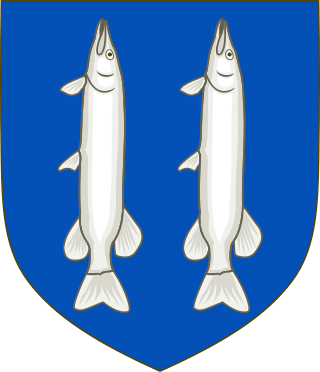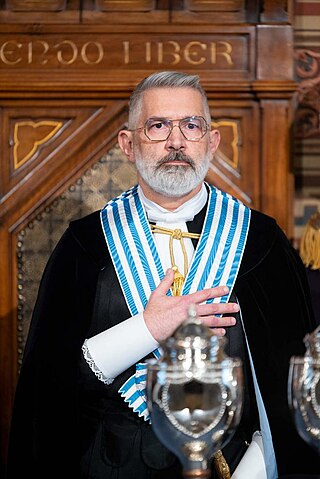Related Research Articles

Pope Clement XII, born Lorenzo Corsini, was head of the Catholic Church and ruler of the Papal States from 12 July 1730 to his death in February 1740.
As the only surviving medieval commune in the Italian Peninsula, the history of San Marino is intertwined with the medieval, Renaissance and modern-day history of the Italian peninsula, according to tradition beginning with its foundation in 301 AD.

Pellegrino Tibaldi, also known as Pellegrino di Tibaldo de Pellegrini, was an Italian mannerist architect, sculptor, and mural painter.

Serravalle is one of the nine castelli of San Marino. It has a population of 10,878 inhabitants and an area of 10.53 km2. It is the most densely populated municipality in San Marino, and contains its largest settlement (Dogana). Serravalle is located on the edge of the Apennine Mountains.

The House of Piccolomini is the name of an Italian noble family, Patricians of Siena, who were prominent from the beginning of the 13th century until the 18th century. The family achieved the recognized titles of Pope of the Catholic Church, Prince of the Holy Roman Empire, Grandee of Spain, and Duke of Amalfi. The family is also featured in Florentine Histories, a book written by Niccolò Machiavelli, where he describes the reign of Pope Pius II, who had allied himself with the Venetians and Prince Vlad Dracula, to wage a war against the Sultan of the Ottoman empire.

The Bentivoglio family was an Italian noble family that became the de facto rulers of Bologna and responsible for giving the city its political autonomy during the Renaissance, although their rule did not survive a century.

Castel del Monte is a medieval and Renaissance hill town and comune in the province of L'Aquila in northern Abruzzo, Italy. Located in the heart of the Gran Sasso mountain range, the town is set into a steep hillside nestled beneath mountain peaks near the high plain of Campo Imperatore. Castel del Monte sits opposite the ancient mountaintop fortress of Rocca Calascio and faces Monte Sirente in the distance. It is located in the Gran Sasso e Monti della Laga National Park. It is one of I Borghi più belli d'Italia.
Tommaso Laureti, often called Tommaso Laureti Siciliano, was an Italian painter from Sicily who trained in the atelier of the aged Sebastiano del Piombo and worked in Bologna. From 1582, he worked for papal patrons in Rome in a Michelangelo-inspired style with special skill in illusionistic perspective, that in his Roman work avoided all but traces of Mannerism.

The Archdiocese of Bologna is a Latin Church ecclesiastical territory or archdiocese of the Catholic Church in Northern Italy. The cathedra is in the cathedral church of San Pietro, Bologna. The current archbishop is Cardinal Matteo Zuppi, who was installed in 2015.

The Simonetti family is an Italian noble family with origins in Tuscany. During the 12th century different branches in Florence, Terni, Lucca, Pistoia and Pescia developed. Other famous branches of this family were established in Jesi, Palermo, Milan and Bologna.

The House of Ruspoli is historically one of the great aristocratic families of Rome, but is originally from Florence. Following World War II and the fall of Fascism, the newly established Italian Republic officially abolished titles and hereditary honours in its 1946 Constitution, with the exception of the papal nobility of Rome, as those titles had been created by papal authority.

The House of Mancini was the name of one of the oldest families of Roman nobility. Their titles and fiefs were numerous: Duke of Nevers and Donzy, Prince of Vergagne and of the Holy Roman Empire with the treatment of Serene Highness, French Peer, Spanish Grandee, Marquis of Fusignano, Count of Montefortino, Viscount of Clamecy, Baron of Tardello, Tumminii and Ogliastro, Lord of Claye-Souilly, Roman noble and Venetian patrician.

Paolo Rondelli is a Sammarinese politician and diplomat who served as Captain Regent of San Marino alongside Oscar Mina from 1 April to 1 October 2022. He is the world's first openly LGBT+ head of state.

Lanza are an Italian noble family that originated in Sicily in the 15th century. Derived from a cadet branch of the Lancia family, barons of Longi, it represents one of the major dynasties of the Sicilian aristocracy.

The Adragna family is an Italian noble house. The family ruled the territory of Altavilla in Sicily, Italy.

The de Piro family is a Maltese noble family, of Italian origins, which settled in Malta with the Order of St John in 1530.
Brandano was a 16th-century Italian preacher and prophet. The sources disagree on his surname: Carosi or Garosi.
Manuel Ciavatta is a Sammarinese politician who was as one of two Captains Regent from 1 October 2022 until 1 April 2023. He served alongside Maria Luisa Berti.
The Basile family, Basili, Bassil, or de Basilio is an ancient family of the Sicilian nobility, invested with the Baronia del Grano in 1473.
Milena Gasperoni is a Sammarinese politician who is one of two Captains Regent for San Marino since April 2024 and serving alongside Alessandro Rossi.